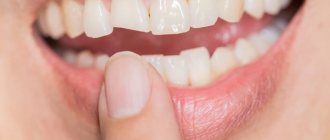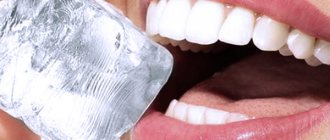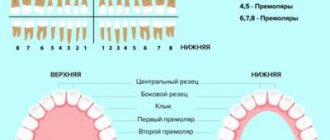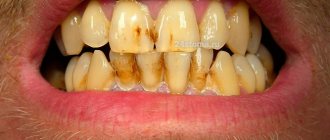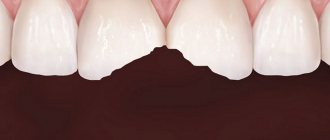Content:
- Why is the position of teeth in a row disturbed?
- Can a crooked tooth fall back into place?
- Consequences of crooked teeth in children
- When should you go to the dentist?
- Devices for correcting uneven teeth
- Prevention Tips
Uneven teeth in children are not only an aesthetic defect. Unfortunately, dental problems can have serious consequences. These include: eating disorders due to improperly chewed food, dysarthria, caries. Due to the uneven arrangement of units in the dentition, plaque accumulates on the enamel due to insufficient hygiene. This leads to the proliferation of pathogenic bacteria, which provokes the formation of caries. That is why you should be careful about your teeth from an early age. My child has uneven teeth, what should I do? It is necessary to visit the pediatric dentist at least twice a year for a preventive examination. Recommended age: children over three years old.
Anomalies in tooth shape
Fournier's teeth
Typically, this anomaly appears in the upper central incisors, where there is a lack of enamel in the central part of the tooth. The dentin itself has a thin layer of enamel or is not covered with it at all. The crowns are barrel-shaped and have a semilunar notch along the edge.
Hutchinson's teeth
Hutchinson's teeth (Hutchinson's teeth) - this anomaly is characteristic of the upper central incisors, which may have serrations. It is also usually accompanied by thinning and discoloration of the enamel along the edge.
Pflueger's teeth
Pfluger's teeth anomaly manifests itself when dentin is underdeveloped and the shape of the crown changes. The first large molars have a crown neck size larger than that of the chewing surface, and the cusps themselves are underdeveloped. This dental anomaly is also called microdentia.
Spike teeth
Typically, the anomaly of tenon teeth refers to the central and lateral incisors of the upper jaw, as well as the lateral incisors of the lower jaw, which take on a cone-shaped shape.
Enamel hyperplasia
This is the so-called excessive formation of hard tissue. With this anomaly, enamel layers of various shapes are formed on the teeth, which can reach 5 mm in diameter. Also about dental hypoplasia.
Giant teeth
Macrodentia or giant teeth are manifested by an increase in the size of the teeth. Most often this refers to the central or lateral incisors of the upper or lower jaw.
Ugly teeth
The anomaly can manifest itself in various forms, ranging from tooth bends to changes in the appearance of the crown.
Why is the position of teeth in a row disturbed?
Why do teeth grow unevenly? There are several reasons, the main ones are listed below.
- Hereditary predisposition. If parents or other close relatives first developed dental problems in childhood, the risk of acquiring an uneven row of teeth increases significantly.
- Deficiency of calcium, phosphorus and other nutrients in the body. The cause may be both nutritional deficiency and digestive tract disorders.
- Pathology that arose in the antenatal period. Due to excess or lack of amniotic fluid, entanglement with the umbilical cord, and the influence of teratogenic drugs, birth defects appear.
- Diseases of the upper respiratory tract, leading to changes in the function of external respiration.
Factors such as irrational and unhealthy diet, pathology of jaw and dental growth also influence. All this leads to the child’s teeth growing unevenly.
Treatment of wedge-shaped dental defects
The treatment process for wedge-shaped dental defects largely depends on the severity of the disease, as well as the stage of its development - early or late.
Early treatment
At the very beginning of the disease, the wedge-shaped defect of the teeth reaches small sizes. This is the most suitable time for treatment - during this period it will not take much time and will not take much effort from the patient.
Treatment of wedge-shaped dental defects in the early stages consists of mineralizing therapy and fluoridation of the enamel. The goal of mineralizing therapy is to improve the health of the enamel and return it to the amount of calcium necessary to perform its protective functions. Mineralization occurs with the help of special compounds, most often in the form of a gel, saturated with calcium. The composition is applied directly to the tooth surface and lasts exactly as long as calcium needs to penetrate into the deep layers of the tooth.
In terms of the method of enamel fluoridation, it is very similar to mineralization. But the purpose of fluoridation is to enrich the outer surface of teeth with another useful element - fluoride. Fluoride has a strong strengthening effect on enamel, reducing the sensitivity of teeth to environmental factors and protecting against the damaging effects of food acids.
To achieve greater efficiency, it is necessary to undergo mineralization and fluoridation procedures of enamel several times. Your dentist will tell you the exact number of procedures.
In the initial stages of wedge-shaped dental defects, the use of desensitive toothpastes is also often recommended. Their main purpose is to reduce pain and acute sensitivity of teeth. But the paste itself does not have a healing effect; it will only help get rid of discomfort during treatment of a wedge-shaped defect.
Only a specialist can determine the treatment program for wedge-shaped dental defects and the stage of the disease. Make an appointment with a dentist right now by calling the clinic at 8 (495) 033-00-63 or using the online appointment form. Our clinic is located near the Shchelkovskaya metro station. People come to us from the Eastern Administrative District of Moscow, from the districts of Izmailovo, Golyanovo and Preobrazhenskaya Square.
Can a crooked tooth fall back into place?
The main question is: does the structure of teeth change over time? Can crooked teeth in childhood cause malocclusion in the future? It is impossible to answer the questions posed unequivocally. The fact is that under the influence of the above reasons for the formation of uneven teeth, the structure of the molars changes. A wide gap forms between the teeth or they grow close to each other. A child has uneven teeth: what to do? First of all, don't panic. In childhood, active growth of the dental apparatus is observed. It is in the period up to 18 years that they are most sensitive to the treatment. At the first suspicion of the formation of uneven teeth, you should immediately seek advice from a pediatric dentist.
Consequences of crooked teeth in children
Due to the fact that a child's teeth grow unevenly, many problems may arise in the future. The fact is that the speech apparatus is formed quite early. From the first months, the child learns to speak correctly, pronounce individual letters and even words. If a baby has dental problems, they will immediately manifest themselves from the first years. The first and most common complaint is the smile. The child will be embarrassed about his smile due to the incorrect position of his teeth. In addition, due to dense dentition, the quality of hygiene procedures decreases. In some cases, additional flossing may be necessary each time you eat. If a child's front teeth grow unevenly, they may even experience headaches. Pain in the neck area is also a common occurrence. This pathology occurs due to excessive tension in the temporomandibular apparatus.
How to make your smile perfect?
In situations where, after orthodontic treatment, dental imperfections, which were not so noticeable before, become noticeable, it is necessary to involve an aesthetic dentist who knows various methods of restoring anterior teeth and is familiar with the capabilities of modern materials. Dentists, by attending seminars and master classes on aesthetic dentistry, as evidenced by doctor certificates, receive the necessary knowledge and skills. The ability of a dentist to find the best solution in each specific case is determined by the breadth of his knowledge in the field of aesthetic dentistry.
Look at the work of our specialists, in which aesthetic correction was performed after orthodontic treatment.
When should you go to the dentist?
What to do if a tooth grows unevenly? The only correct answer is to seek help from specialists at a dental clinic where children's doctors are seen. You should be examined at least twice annually to monitor the dynamics of the process. You should go to the dentist if your child has unevenly set teeth. After the conversation and diagnostic measures, the dentist will be able to give an accurate answer. Treatment may require special devices that should be worn for a long time. Mouthguards, braces, trainers and other devices for changing malocclusion will help cope with the problem.
Example 1
The photo shows teeth after orthodontic treatment. The dentition is aligned, but the upper front teeth do not make the smile beautiful.
Here is a view of the teeth after whitening several shades and restoring the front teeth with Spectrum composite material. A small addition to orthodontic treatment significantly changed the patient’s appearance and sense of self.
Many patients believe that teeth whitening makes their smile unnatural. But an experienced specialist can whiten your teeth by literally one or two shades, which will simply make them a little lighter. However, this “slightly” well rejuvenates a person’s entire appearance, makes the face fresher, and those around them have no idea that teeth whitening .
Compare the smile before teeth whitening and restoration and after the work is completed.
| Before correction | After bleaching and restoration |
Devices for correcting uneven teeth
There are several reliable and effective treatment methods. They differ from each other in some respects. To choose the best option, you should talk to a pediatric dentist who treats children’s teeth. Trainers and removable plates.
They can be used from an early age. Recommended age is 4-6 years. In this case, it is necessary to wear trainers every day; they are often worn at night. The significant difference is that the device is removable.
Aligner trays.
They begin to wear them at the age of 16.
You need to wear them constantly and take them off only when eating. Braces.
They are given mainly to persons over 18 years of age. They need to be worn for a long time, on average about two years.
Prevention Tips
How to prevent the formation of an uneven bite? There are some tips:
- provide the child with proper and balanced nutrition according to his age from the first years of life;
- closely monitor the child’s health;
- prevent the formation of incorrect habits, such as constant chewing on one side or sucking fingers;
- Carry out thorough oral hygiene every day.
It should also be noted that once a child reaches 1 year of age, he should be weaned off pacifiers. The fact is that mechanical action changes the structure of a child’s front teeth. The pacifier can be replaced with special vestibular plates that repeat the anatomical features of the structure of the child’s teeth.
